3-Hydroxyl-3-methylglutaryl coenzyme A (HMG-CoA) reductase inhibitor (statin)-induced 28-kDa interleukin-1β interferes with mature IL-1β signaling
- PMID: 24790079
- PMCID: PMC4047391
- DOI: 10.1074/jbc.M114.571505
3-Hydroxyl-3-methylglutaryl coenzyme A (HMG-CoA) reductase inhibitor (statin)-induced 28-kDa interleukin-1β interferes with mature IL-1β signaling
Abstract
Multiple clinical trials have shown that the 3-hydroxyl-3-methylglutaryl coenzyme A (HMG-CoA) reductase inhibitors known as statins have anti-inflammatory effects. However, the underlying molecular mechanism remains unclear. The proinflammatory cytokine interleukin-1β (IL-1β) is synthesized as a non-active precursor. The 31-kDa pro-IL-1β is processed into the 17-kDa active form by caspase-1-activating inflammasomes. Here, we report a novel signaling pathway induced by statins, which leads to processing of pro-IL-1β into an intermediate 28-kDa form. This statin-induced IL-1β processing is independent of caspase-1- activating inflammasomes. The 28-kDa form of IL-1β cannot activate interleukin-1 receptor-1 (IL1R1) to signal inflammatory responses. Instead, it interferes with mature IL-1β signaling through IL-1R1 and therefore may dampen inflammatory responses initiated by mature IL-1β. These results may provide new clues to explain the anti-inflammatory effects of statins.
Keywords: Atherosclerosis; Caspase; Immunology; Inflammation; Innate Immunity; Interleukin.
© 2014 by The American Society for Biochemistry and Molecular Biology, Inc.
Figures
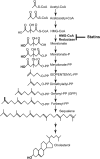
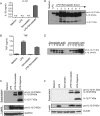

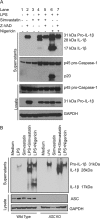
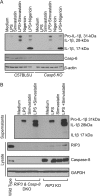

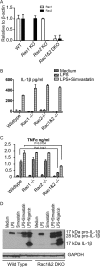
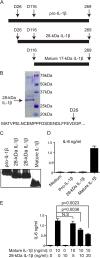
Similar articles
-
Statins repress needle-like carbon nanotube- or cholesterol crystal-stimulated IL-1β production by inhibiting the uptake of crystals by macrophages.Biochem Pharmacol. 2021 Jun;188:114580. doi: 10.1016/j.bcp.2021.114580. Epub 2021 Apr 28. Biochem Pharmacol. 2021. PMID: 33930349
-
HMG-CoA reductase inhibitors activate caspase-1 in human monocytes depending on ATP release and P2X7 activation.J Leukoc Biol. 2013 Feb;93(2):289-99. doi: 10.1189/jlb.0812409. Epub 2012 Nov 16. J Leukoc Biol. 2013. PMID: 23159926
-
Acidosis drives damage-associated molecular pattern (DAMP)-induced interleukin-1 secretion via a caspase-1-independent pathway.J Biol Chem. 2013 Oct 18;288(42):30485-30494. doi: 10.1074/jbc.M113.478941. Epub 2013 Sep 10. J Biol Chem. 2013. PMID: 24022484 Free PMC article.
-
IL-1β and IL-18: inflammatory markers or mediators of hypertension?Br J Pharmacol. 2014 Dec;171(24):5589-602. doi: 10.1111/bph.12876. Br J Pharmacol. 2014. PMID: 25117218 Free PMC article. Review.
-
Pluripotential mechanisms of cardioprotection with HMG-CoA reductase inhibitor therapy.Am J Cardiovasc Drugs. 2001;1(6):411-20. doi: 10.2165/00129784-200101060-00001. Am J Cardiovasc Drugs. 2001. PMID: 14728000 Review.
Cited by
-
Molecular mechanisms underlying the effects of statins on bone metabolism: an evolving paradigm of statins delivery modalities for bone regeneration.Pharmacol Rep. 2025 Jun;77(3):624-644. doi: 10.1007/s43440-025-00716-7. Epub 2025 Apr 1. Pharmacol Rep. 2025. PMID: 40167878 Review.
-
A Fluorescent Reporter Mouse for Inflammasome Assembly Demonstrates an Important Role for Cell-Bound and Free ASC Specks during In Vivo Infection.Cell Rep. 2016 Jul 12;16(2):571-582. doi: 10.1016/j.celrep.2016.06.011. Epub 2016 Jun 23. Cell Rep. 2016. PMID: 27346360 Free PMC article.
-
Serum CD121a (Interleukin 1 Receptor, Type I): A Potential Novel Inflammatory Marker for Coronary Heart Disease.PLoS One. 2015 Jun 22;10(6):e0131086. doi: 10.1371/journal.pone.0131086. eCollection 2015. PLoS One. 2015. PMID: 26098632 Free PMC article.
-
Inflammation Combined with Ischemia Produces Myelin Injury and Plaque-Like Aggregates of Myelin, Amyloid-β and AβPP in Adult Rat Brain.J Alzheimers Dis. 2015;46(2):507-23. doi: 10.3233/JAD-143072. J Alzheimers Dis. 2015. PMID: 25790832 Free PMC article.
-
Respiratory Tract Infections in Diabetes - Lessons From Tuberculosis and Influenza to Guide Understanding of COVID-19 Severity.Front Endocrinol (Lausanne). 2022 Jul 26;13:919223. doi: 10.3389/fendo.2022.919223. eCollection 2022. Front Endocrinol (Lausanne). 2022. PMID: 35957811 Free PMC article. Review.
References
-
- Goldstein J. L., Brown M. S. (1990) Regulation of the mevalonate pathway. Nature 343, 425–430 - PubMed
-
- Downs J. R., Clearfield M., Weis S., Whitney E., Shapiro D. R., Beere P. A., Langendorfer A., Stein E. A., Kruyer W., Gotto A. M., Jr. (1998) Primary prevention of acute coronary events with lovastatin in men and women with average cholesterol levels: results of AFCAPS/TexCAPS. Air Force/Texas Coronary Atherosclerosis Prevention Study. JAMA 279, 1615–1622 - PubMed
-
- Shepherd J., Cobbe S. M., Ford I., Isles C. G., Lorimer A. R., MacFarlane P. W., McKillop J. H., Packard C. J. (1995) Prevention of coronary heart disease with pravastatin in men with hypercholesterolemia. West of Scotland Coronary Prevention Study Group. N. Engl. J. Med. 333, 1301–1307 - PubMed
-
- The Long-Term Intervention with Pravastatin in Ischaemic Disease (LIPID) Study Group (1998) Prevention of cardiovascular events and death with pravastatin in patients with coronary heart disease and a broad range of initial cholesterol levels. N. Engl. J. Med. 339, 1349–1357 - PubMed
-
- Sacks F. M., Pfeffer M. A., Moye L. A., Rouleau J. L., Rutherford J. D., Cole T. G., Brown L., Warnica J. W., Arnold J. M., Wun C. C., Davis B. R., Braunwald E. (1996) The effect of pravastatin on coronary events after myocardial infarction in patients with average cholesterol levels. Cholesterol and Recurrent Events Trial investigators. N. Engl. J. Med. 335, 1001–1009 - PubMed
Publication types
MeSH terms
Substances
Grants and funding
LinkOut - more resources
Full Text Sources
Other Literature Sources
Medical

